

Turbulence: Does Vorticity Affect the Structure and Shape of Body and Fin Propulsors? Skip to Main Content Sign In Register Advanced Search Online ISSN 1557-7023 Print ISSN 1540-7063 Copyright © 2017 The Society for Integrative and Comparative Biology Connect Resources Explore Oxford University Press is a department of the University of Oxford.
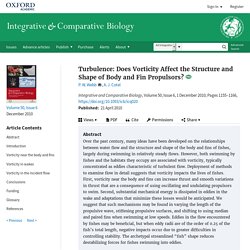
Close. Body uses vortices to save energy : Rainbow Trout And Steelhead - AskNature. Video Shows How A Dead Trout Can Swim Upstream - FishSens Magazine - FishSens Magazine. Body uses vortices to save energy : Rainbow Trout And Steelhead - AskNature. Turbulence: Does Vorticity Affect the Structure and Shape of Body and Fin Propulsors? Tuna swimming in a large pool. THE OCEAN SUNFISH: LARGEST BONY FISH. Fluid locomotion simulation. Fish Race: Gallery of Fluid Motion 2009. Figure 3. Most fishes move by generating an undulating wave... Figure 3.
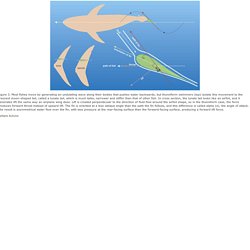
Most fishes move by generating an undulating wave along their bodies that pushes water backwards, but thunniform swimmers (top) isolate this movement to the crescent moon–shaped tail, called a lunate tail, which is much taller, narrower and stiffer than that of other fish. In cross section, the lunate tail looks like an airfoil, and it generates lift the same way an airplane wing does. Lift is created perpendicular to the direction of fluid flow around the airfoil shape, so in the thunniform case, the force produces forward thrust instead of upward lift. The fin is oriented at a less oblique angle than the path the fin follows, and this difference is called alpha (α), the angle of attack. The result is asymmetrical water flow over the fin, with less pressure at the rear-facing surface than the forward-facing surface, producing a forward lift force.
How Tunas and Lamnid Sharks Swim: An Evolutionary Convergence. These fishes diverged millions of years ago, but selection pressures have brought them very similar biomechanical schemes for movement Robert Shadwick Form and Function Tunas and lamnids are among the most active apex predators cruising the world's oceans, and both groups have evolved as specialists, in similar ways, for a highly active lifestyle.
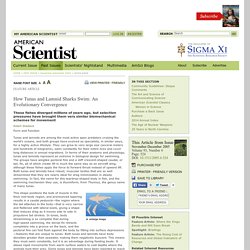
They can grow to very large size (several meters and hundreds of kilograms), swim constantly for their entire lives and cover long distances in annual migrations. Patents. Patents. Underwater Propulsion: A Tale of Tails Dive Training Magazine. After almost every dive someone immediately begins to try to describe a fish they saw.

The first questions they are asked in response are “what did it look like, how big was it, what color was it, and what was it doing?” At that point you are very likely to hear something about the fish’s body shape, size and color, the look of its face, eyes and mouth, and a comment or two about whether the animal was striped or had spots or other distinct markings, and where the fish was seen.
But only on rare occasions does anyone comment about a fish’s tail. Whether the fish in question is big or small, a shark or a reef fish, especially attractive or average looking, the tail usually fails to get much consideration. Primary Purpose is Propulsion. Animals' Wing and Fin Motions Share Universal Propulsion Geometry. Michael L.

Baird/flickr Whale tails and bird wings bend in similar ways as they move through water and air. Most animals that fly or swim bend their wings or fins in similar geometrical proportions and by similar angles, a study says. The seemingly universal principle, which applies to creatures as diverse as moths and sharks, holds lessons for researchers designing devices that propel themselves through air or water. The work is published today in Nature Communications1. Reynolds number. The plume from this candle flame goes from laminar to turbulent.
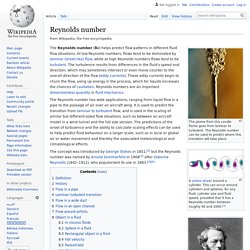
The Reynolds number can be used to predict where this transition will take place. A vortex street around a cylinder. This can occur around cylinders and spheres, for any fluid, cylinder size and fluid speed, provided that the flow has a Reynolds number between roughly 40 and 1000.[1] The concept was introduced by George Gabriel Stokes in 1851,[2] but the Reynolds number was named by Arnold Sommerfeld in 1908[3] after Osborne Reynolds (1842–1912), who popularized its use in 1883.[4][5] Definition[edit] Rspb.2011.0489. Abstract Understanding how moving organisms generate locomotor forces is fundamental to the analysis of aerodynamic and hydrodynamic flow patterns that are generated during body and appendage oscillation.

In the past, this has been accomplished using two-dimensional planar techniques that require reconstruction of three-dimensional flow patterns. We have applied a new, fully three-dimensional, volumetric imaging technique that allows instantaneous capture of wake flow patterns, to a classic problem in functional vertebrate biology: the function of the asymmetrical (heterocercal) tail of swimming sharks to capture the vorticity field within the volume swept by the tail.
The Secret of Super-Fast Shark Swimming. By Elizabeth Pennisi, ScienceNOW Researchers have discovered what makes the shark almost impossible to outswim.
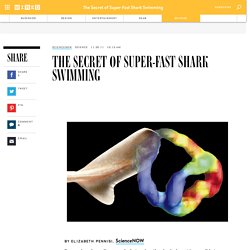
By using an engineering imaging technique, researchers have discovered that as a shark’s tail swings from side to side, it creates twice as many jets of water as other fishes’ tails, smoothing out the thrust and likely making swimming more efficient. Sharks do this by stiffening the tail midswing, a strategy that might one day be applied to underwater vehicles to improve their performance.